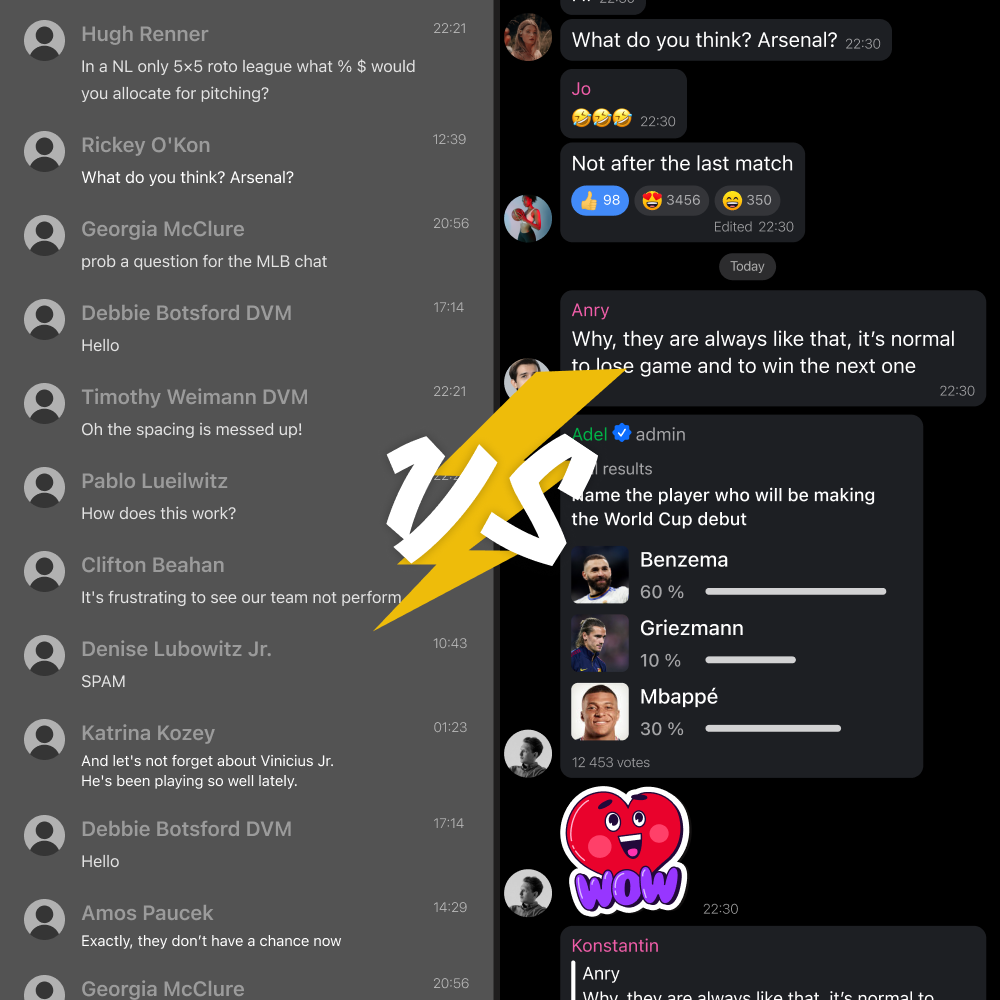How and Why to Integrate Live Chat: Crucial Reasons and Simple Steps
Exploring how community-based live chat has positively impacted the utility of various platforms and how to integrate it easily.
User retention and engagement growth are among the most critical performance metrics for any digital platform. Research shows that improving customer retention rates by just 5% can increase profits by up to 95% (Bain & Company). One of the most effective ways to achieve this is through community-based live chat features, which encourage users to connect, share experiences, and return regularly to your platform.
Think of it as creating a digital coffee table — a place where your users naturally gather to discuss shared passions, whether it’s sports, language learning, or TV series. With the right tools, your platform becomes a hub of conversation, loyalty, and repeat engagement.
Why Add Community Live Chat to Your Platform?
Reclaim Users from Social Media
Businesses spend millions building audiences on social networks, but without in-app chat, users drift to external platforms to share their opinions. By implementing real-time chat functionality, you ensure conversations happen on your website or app, not on Facebook, X, or Instagram.
Users spend 2x longer on platforms with integrated chat.
Engagement increases by 30–40% when community features are available.
A prime example is La Liga.
Despite millions of social media followers, La Liga struggled with limited access to first-party user data. By launching an app-based chat and “second-screen” experience via QR codes, they not only attracted fans directly to their app but also gained valuable behavioural insights. This move strengthened fan communities and boosted in-app retention rates significantly.
Differentiate from Competitors
When users compare platforms, they choose the one offering the most interactive and engaging experience. Adding community live chat creates the same “stickiness” as social media — people log back in to check conversations, respond to mentions, and catch up with peers.
Platforms with unique social features report a 25% higher return rate compared to those without.
Keeping users engaged in-app also reduces exposure to competitor advertising.
Increase Retention Rates
The number one challenge for digital platforms is customer churn. Studies reveal that the average app loses 77% of daily active users (DAUs) within three days of installation. Community-based live chat directly combats this by encouraging frequent interaction, keeping users active and invested.
Retention improves by 15–20% with integrated chat and community features.
Users who feel part of a community are 3x more likely to remain loyal to a brand.
Understand your customers’ needs and pains
Traditional analytics and support tickets show limited behaviour patterns — usually focused on problems. Live chat provides authentic insights into user interests, habits, and needs.
You can track:
Which topics spark the most conversation.
When your audience is most active.
How users engage with specific content.
This allows you to refine your platform, create more relevant content, and build a data-driven engagement strategy.

How to Implement In-App Live Chat
Launching a community chat feature doesn’t have to be complex. Using modern SDKs, chat APIs, and webview integrations, you can quickly add scalable live chat functionality without lengthy development cycles.
Key Steps:
Define Chat Visibility
Will chat be open to all visitors or only authenticated users? Similar to a paywall, you can require a login or a subscription to participate.
Choose Authentication
Allow users to chat under their platform profile or create anonymous nicknames.
Set the Entry Point
Place chat where it drives the most value (homepage, event pages, video content, or live streams).
Customise and Moderate
Tailor the chat design, enable moderation features, and integrate engagement tools like polls, quizzes, or interactive widgets to keep discussions lively.
By following these steps, you can create an engaging community that drives user retention, improves brand loyalty, and enhances the overall experience on your platform. By keeping conversations inside your platform, you gain control over user behaviour insights, reduce churn, and strengthen your competitive edge.
***
Get In Touch
Book a call if you'd like to integrate in-app community chats with the high-level moderation system into your website, app, or game. We'll be happy to help you find the best solution.
Boost your platform with
Watchers embedded tools for ultimate engagement
